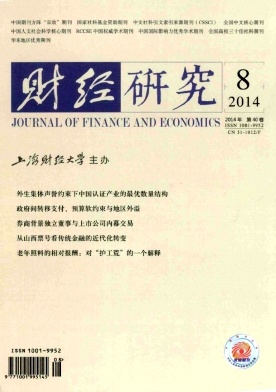需求规模、异质性研发与生产率——基于ACF法的实证研究
财经研究 2014 年 第 40 卷第 08 期, 页码:42 - 56
摘要
参考文献
摘要
需求规模扩大对鼓励企业加大研发投入和提升生产率水平至关重要。文章使用2003-2011年制造业上市企业的面板数据,利用ACF法测算了生产率,率先在企业层面考察了需求规模如何通过异质性研发投入支撑了生产率增长。结果表明,需求规模的扩大对生产率水平低的企业的影响超过了对生产率水平高的企业的影响;只有当需求规模超过门槛值后(LnD>24.9780),异质性研发投入增加才能促进生产率增长。结论表明,未来的政策设计应转向研发激励和需求侧创新并重的政策组合。
[1]陈爱贞,刘志彪,吴福象.下游动态技术引进对装备制造业升级的市场约束——基于我国纺织缝制装备制造业的实证研究[J].管理世界,2008,(2):72-81.
[2]陈丰龙,徐康宁.本土市场规模与中国制造业全要素生产率[J].中国工业经济,2012,(5):44-56.
[3]邓可斌,丁重.中国为什么缺乏创造性破坏——基于上市公司特质信息的经验证据[J].经济研究,2010,(6):66-79.
[4]范红忠.有效需求规模假说、研发投入与国家自主创新能力[J].经济研究,2007,(3):33-44.
[5]黄枫,吴纯杰.市场势力测度与影响因素分析——基于我国化学药品制造业研究[J].经济学(季刊),2013,(2):511-526.
[6]江小涓.我国出口商品结构的决定因素和变化趋势[J].经济研究,2007,(5):4-16.
[7]简泽,段永瑞.企业异质性、竞争与全要素生产率的收敛[J].管理世界,2012,(8):15-29.
[8]刘小玄,吴延兵.企业生产率增长及来源:创新还是需求拉动[J].经济研究,2009,(7):45-54.
[9]罗德明,李晔,史晋川.要素市场扭曲、资源错配与生产率[J].经济研究,2012,(3):4-14.
[10]鲁晓东,连玉君.中国工业企业全要素生产率估计:1999-2007[J].经济学(季刊),2012,(2):541-558.
[11]任曙明,原毅军,王洪静.损失厌恶、需求萎缩与装备制造业技术升级[J].科学学研究,2012,(3):387-393.
[12]孙浦阳,蒋为,张龑.产品替代性与生产率分布——基于中国制造业企业数据的实证[J].经济研究,2013,(4):30-42.
[13]巫强,刘志彪.本土装备制造业市场空间障碍分析——基于下游行业全球价值链的视角[J].中国工业经济,2012,(3):43-55.
[14]吴延兵.R&D与生产率——基于中国制造业的实证研究[J].经济研究,2006,(11):60-71.
[15]游家兴,张俊生,江伟.制度建设、公司特质信息与股价波动的同步性——基于R2研究的视角[J].经济学(季刊),2007,(1):189-206.
[16]周亚虹,贺小丹,沈瑶.中国工业企业自主创新的影响因素和产业绩效研究[J].经济研究,2012,(5):107-119.
[17]文芳,胡玉明.中国上市公司高管个人特征与R&D投资[J].管理评论,2009,(11):84-91.
[18]Ackerberg D,Caves K,Frazer G.Structural identification of production functions[R].MPRA Paper,2006.
[19]Ackerberg D,Benkard L,Berry S,et al..Econometric tools for analyzing market outcomes[J].Handbook of Econometrics,2007,(6):4173-4276.
[20]Aghion P,Griffith R.Competition and growth:Reconciling theory and evidence[M].Cambridge:MIT Press,2005.
[21]Aw B,Roberts M,Xu D.R&D investment,exporting,and productivity dynamics[J].American Economic Review,2011,101(4):1312-1344.
[22]Bartelsman E.Searching for the sources of productivity from macro to micro and back[J].Industrial and Corporate Change,2010,19(6):1891-1917.
[23]Bartelsman E,Halterwanger J,Scarpetta S.Cross-country differences in productivity:The role of allocation and selection[J].American Economic Review,2013,103(1):305-334.
[24]Bustos P.Trade liberalization,exports and technology upgrading:Evidence on the impact of MERCOSUR on Argentinean firms[J].American Economic Review,2011,101(1):304-340.
[25]Caselli F,Coleman W.The world technology frontier[J].American Economic Review,2006,96(3):499-522.
[26]Chun H,Kim J,Morck R,et al.Creative destruction and firm-specific performance heterogeneity[J].Journal of Financial Economics,2008,89(1):109-135.
[27]Daron A,Joshua L.Market size in innovation:Theory and evidence from the pharmaceutical industry[J].The Quarterly Journal of Economics,2004,119(3):1049-1090.
[28]Heckman J.Micro data,heterogeneity,and the evaluation of public policy:Nobel lecture[J].Journal of Political Economy,2001,109(4):673-748.
[29]Jorgenson D,Ho M,StirohK.Growth of US industries and investments in information technology and higher education[J].Economic System Research,2003,15(3):279-325.
[30]Levinsohn J,Petrin A.Estimating production functions using inputs to control for unobservable[J].Review of Economic Studies,2003,70(2):317-341.
[31]Lileeva A,Daniel T.Improved access to foreign markets raises plant-level productivity for some plants[J].Quarterly Journal of Economics,2010,125(3):1051-1099.
[32]Olley G,Pakes A.The dynamics of productivity in the telecommunications equipment industry[J].Econometric,1996,64(6):1263-1297.
[33]Pastor L,Veronesi P.Technological revolutions and stock prices[J].American Economic Review,2009,99(4):1451-1483.
[34]Roll R.R2[J].Journal of Finance,1988,43(3):541-566.
[35]Smith K.Measuring innovation,in Fagerberg J(ed)[M].The Oxford Handbook of Innovation,Oxford University Press,2005.
[36]Syverson C.What determines productivity[J].Journal of Economic Literature,2011,49(2):326-365.
[37]Syverson C.Market structure and productivity:A concrete example[J].Journal of Political Economy,2004,112(6):1181-1222.
[2]陈丰龙,徐康宁.本土市场规模与中国制造业全要素生产率[J].中国工业经济,2012,(5):44-56.
[3]邓可斌,丁重.中国为什么缺乏创造性破坏——基于上市公司特质信息的经验证据[J].经济研究,2010,(6):66-79.
[4]范红忠.有效需求规模假说、研发投入与国家自主创新能力[J].经济研究,2007,(3):33-44.
[5]黄枫,吴纯杰.市场势力测度与影响因素分析——基于我国化学药品制造业研究[J].经济学(季刊),2013,(2):511-526.
[6]江小涓.我国出口商品结构的决定因素和变化趋势[J].经济研究,2007,(5):4-16.
[7]简泽,段永瑞.企业异质性、竞争与全要素生产率的收敛[J].管理世界,2012,(8):15-29.
[8]刘小玄,吴延兵.企业生产率增长及来源:创新还是需求拉动[J].经济研究,2009,(7):45-54.
[9]罗德明,李晔,史晋川.要素市场扭曲、资源错配与生产率[J].经济研究,2012,(3):4-14.
[10]鲁晓东,连玉君.中国工业企业全要素生产率估计:1999-2007[J].经济学(季刊),2012,(2):541-558.
[11]任曙明,原毅军,王洪静.损失厌恶、需求萎缩与装备制造业技术升级[J].科学学研究,2012,(3):387-393.
[12]孙浦阳,蒋为,张龑.产品替代性与生产率分布——基于中国制造业企业数据的实证[J].经济研究,2013,(4):30-42.
[13]巫强,刘志彪.本土装备制造业市场空间障碍分析——基于下游行业全球价值链的视角[J].中国工业经济,2012,(3):43-55.
[14]吴延兵.R&D与生产率——基于中国制造业的实证研究[J].经济研究,2006,(11):60-71.
[15]游家兴,张俊生,江伟.制度建设、公司特质信息与股价波动的同步性——基于R2研究的视角[J].经济学(季刊),2007,(1):189-206.
[16]周亚虹,贺小丹,沈瑶.中国工业企业自主创新的影响因素和产业绩效研究[J].经济研究,2012,(5):107-119.
[17]文芳,胡玉明.中国上市公司高管个人特征与R&D投资[J].管理评论,2009,(11):84-91.
[18]Ackerberg D,Caves K,Frazer G.Structural identification of production functions[R].MPRA Paper,2006.
[19]Ackerberg D,Benkard L,Berry S,et al..Econometric tools for analyzing market outcomes[J].Handbook of Econometrics,2007,(6):4173-4276.
[20]Aghion P,Griffith R.Competition and growth:Reconciling theory and evidence[M].Cambridge:MIT Press,2005.
[21]Aw B,Roberts M,Xu D.R&D investment,exporting,and productivity dynamics[J].American Economic Review,2011,101(4):1312-1344.
[22]Bartelsman E.Searching for the sources of productivity from macro to micro and back[J].Industrial and Corporate Change,2010,19(6):1891-1917.
[23]Bartelsman E,Halterwanger J,Scarpetta S.Cross-country differences in productivity:The role of allocation and selection[J].American Economic Review,2013,103(1):305-334.
[24]Bustos P.Trade liberalization,exports and technology upgrading:Evidence on the impact of MERCOSUR on Argentinean firms[J].American Economic Review,2011,101(1):304-340.
[25]Caselli F,Coleman W.The world technology frontier[J].American Economic Review,2006,96(3):499-522.
[26]Chun H,Kim J,Morck R,et al.Creative destruction and firm-specific performance heterogeneity[J].Journal of Financial Economics,2008,89(1):109-135.
[27]Daron A,Joshua L.Market size in innovation:Theory and evidence from the pharmaceutical industry[J].The Quarterly Journal of Economics,2004,119(3):1049-1090.
[28]Heckman J.Micro data,heterogeneity,and the evaluation of public policy:Nobel lecture[J].Journal of Political Economy,2001,109(4):673-748.
[29]Jorgenson D,Ho M,StirohK.Growth of US industries and investments in information technology and higher education[J].Economic System Research,2003,15(3):279-325.
[30]Levinsohn J,Petrin A.Estimating production functions using inputs to control for unobservable[J].Review of Economic Studies,2003,70(2):317-341.
[31]Lileeva A,Daniel T.Improved access to foreign markets raises plant-level productivity for some plants[J].Quarterly Journal of Economics,2010,125(3):1051-1099.
[32]Olley G,Pakes A.The dynamics of productivity in the telecommunications equipment industry[J].Econometric,1996,64(6):1263-1297.
[33]Pastor L,Veronesi P.Technological revolutions and stock prices[J].American Economic Review,2009,99(4):1451-1483.
[34]Roll R.R2[J].Journal of Finance,1988,43(3):541-566.
[35]Smith K.Measuring innovation,in Fagerberg J(ed)[M].The Oxford Handbook of Innovation,Oxford University Press,2005.
[36]Syverson C.What determines productivity[J].Journal of Economic Literature,2011,49(2):326-365.
[37]Syverson C.Market structure and productivity:A concrete example[J].Journal of Political Economy,2004,112(6):1181-1222.
引用本文
任曙明, 孙飞. 需求规模、异质性研发与生产率——基于ACF法的实证研究[J]. 财经研究, 2014, 40(8): 42–56.
导出参考文献,格式为:





 8077
8077  3988
3988

